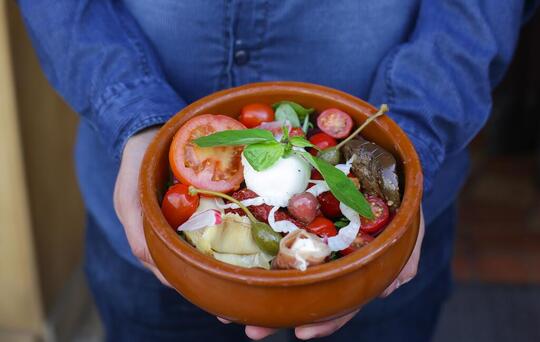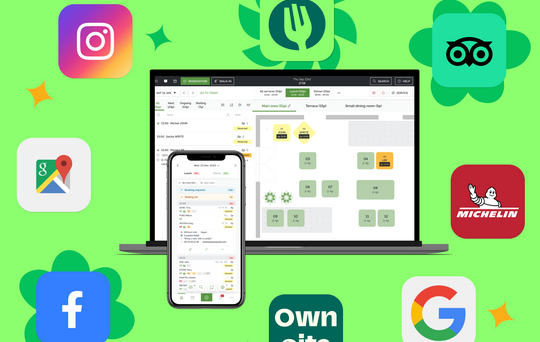Eco-friendly restaurants: all you need to know

In response to the urgent need to address climate change, businesses across every industry are closely examining their environmental footprint. As a responsible restaurant owner and concerned citizen, chances are you have already considered how to make your restaurant more eco-friendly. However, like many others, you are probably very busy and not sure where to start. You may also be wondering how integrating sustainability into your operations could impact your bottom line.
The good news is that there are some fairly simple steps you can take to make your restaurant more eco-friendly while still providing a memorable dining experience that both you and your customers can feel good about. While transitioning to a more environmentally friendly business will involve an initial investment in time and money, the potential benefits are huge, especially in terms of operational efficiency and customer satisfaction.
Do consumers care about eco-friendly restaurants?
Consumers are paying closer attention than ever to how restaurants deal with challenges like food waste, sourcing, energy consumption, and packaging. According to a recent study across 12 European countries,* over half of consumers agree that sustainability concerns have at least some (42.6%) or a lot (16.6%) of influence on their eating habits. In the UK, according to a YouGov and WaterAid poll, 70% of people believe that restaurants should do everything they can to be as sustainable as possible in every aspect of their business.
While the environmental pressure on restaurateurs is growing, the needs of environmentally concerned customers are still not being met. Why not give your guests one more reason to feel good about eating at your establishment by setting an example as an eco-friendly restaurant in your community? In addition to engaging with a new segment of customers, you can actually save money by reducing your energy consumption and lowering food waste. As a further benefit, some studies show that staff in eco-friendly restaurants tend to feel more engaged and happier at work, contributing to better long-term staff retention and improving the overall customer experience.
Becoming an eco-friendly restaurant is an ongoing process that requires targeted and practical actions. There are many steps that a UK restaurant can take to move towards adopting a farm-to-fork, sustainable ethos.
Effective strategies to reduce food waste in restaurants
Food waste is a huge global issue. According to the 2021 Food Waste Index Report,*** it is estimated that around 931 million tonnes of food waste was generated in 2019, 26% of which comes from the restaurant industry. Food waste alone generates around 8 to 10% of global greenhouse gases.
Fortunately, there are many simple ways to minimise your restaurant’s food waste. As well as being good for the environment, this is also an opportunity to save money.
Here’s how to begin.
🗑️A waste audit: the first step
A waste audit involves keeping a record for a week or longer of exactly how much and what kind of food is being discarded. While this can mean quite literally digging through your food waste, the process can give valuable insight into what may need to change in your kitchen.
To conduct a proper waste audit, follow these steps:
- prepare the necessary equipment (i.e. bags, buckets, a sorting table…).
- sort and separate waste daily into prep-work scraps, spoiled food, plate waste etc.
- weigh, record and analyse your food waste streams
Once you have begun tackling your waste issue through more efficient food use, it is time to make your menu more eco-friendly.
🍽️Adapt portion sizes
If your food waste audit shows a lot of plate loss, perhaps your portions are too big. Try reducing them up to 20% or offering two-size options — a small plate for lighter eaters and a bigger dish for those who want to eat more.
Encourage diners to feel comfortable asking for a “doggy bag”. While this is common in the US, many countries, including the UK, don’t regularly send customers home with leftovers. According to a survey by the Sustainable Restaurant Association (RSA), 25% of British diners still feel embarrassed asking to take leftovers home.
🥗Use “trash” or zero-waste cooking techniques
“Trash” cooking means using all of your ingredients fully, with the goal of producing zero food waste. This can be useful if you find that you usually have a lot of scrap.
Think of “nose-to-tail and root-to-stem” cooking. Instead of tossing radish leaves, put them in a salad. Why just serve broccoli florets in a stir-fry when their stalks can also be roasted? If you’re making pumpkin soup, save and roast the seeds for a tasty and crunchy mixed salad.
When cooking fish, don’t just use the fillets but also the head and bones to make fish stock. You can also cut the bones clean and use scraps to make croquettes, fish balls or a stew. The creative possibilities of zero-waste cooking for an eco-friendly restaurant are endless!
Try TheFork Manager today
📱Sign up with a Food app
Nowadays, there are a number of food apps designed to help restaurants reduce their food waste.
To benefit from these sustainable restaurant and cooking practices, check out Good to Go or Karma. Show your customers that you care about the environment!
🌱Set up composting
If composting is still optional in your community, voluntarily set up a waste collection station and advertise it. This will minimise your restaurant's carbon footprint while also reducing food waste.
Whether you own a plant-based cafe or a Michelin-starred restaurant, being seen to champion composting in your area can only strengthen your reputation, proving your commitment to sustainable practices.
Sustainable sourcing and farm-to-table practices
Do you want to support local farmers by choosing fresh, high-quality produce? This is the ethos behind sustainable sourcing.
The practice consists of seeking out farm-to-table, seasonal ingredients for your dishes. As a result, you could benefit from:
- Strengthened community relationships
- Prioritization of value provided by the local economy
- Carbon neutrality
- Lowered food waste
Some of the most successful farm-to-table initiatives are those of SILO, a Michelin-starred restaurant located in Unit 7 Queens Yard Hackney Wick, London, and Petersham Nurseries. These are both shining examples of how prioritizing seasonal produce, biodynamic wine, and other sustainably sourced ingredients can contribute to creating an impeccable eco-friendly experience.
Another relevant dining establishment on the London scene is Adam Handling’s Frog, a plant-based restaurant. The philosophy behind the chef’s small plates is to put on a show with unfiltered interactions between customers and kitchen staff while also blending sustainability and luxury, offering an incredible journey.
Improve energy efficiency in restaurant operations
To be eco-friendly, restaurants must take steps to effectively reduce energy consumption. One way to do this is by choosing energy-efficient appliances that consume less electricity while still maintaining a professional performance.
Another effective change is to invest in smart thermostats. These devices work to regulate temperature only when necessary. Furthermore, to take eco-friendly energy consumption in your restaurant to the next level, consider switching to renewable electricity for your daily kitchen activities.
These practices will help reduce your restaurant’s carbon footprint, leading to lower costs over time.
Implement eco-friendly disposables
Opting for biodegradable, compostable, and recycled materials for your eco-friendly restaurant is crucial to reducing your activity’s environmental impact.
There are many green alternatives for modern, plant-based and sustainable restaurants. Consider:
- Cornstarch-based cutlery
- Bamboo plates
- FSC-certified paper products from responsibly managed forests or recycled sources to help foster a circular economy.
Another improvement for your eco-restaurant could be to provide clear disposal guidelines to all staff and customers, helping others make more sustainable choices.
Summarising …
By integrating these eco-friendly practices into your operations, you will:
- Reduce your carbon footprint
- Potentially improve your ROI
- Create new avenues for engagement with both staff and customers
Don’t forget to let everyone know about all of your greener efforts! Communicate transparently and regularly about your new daily practices to help tackle climate change!

















